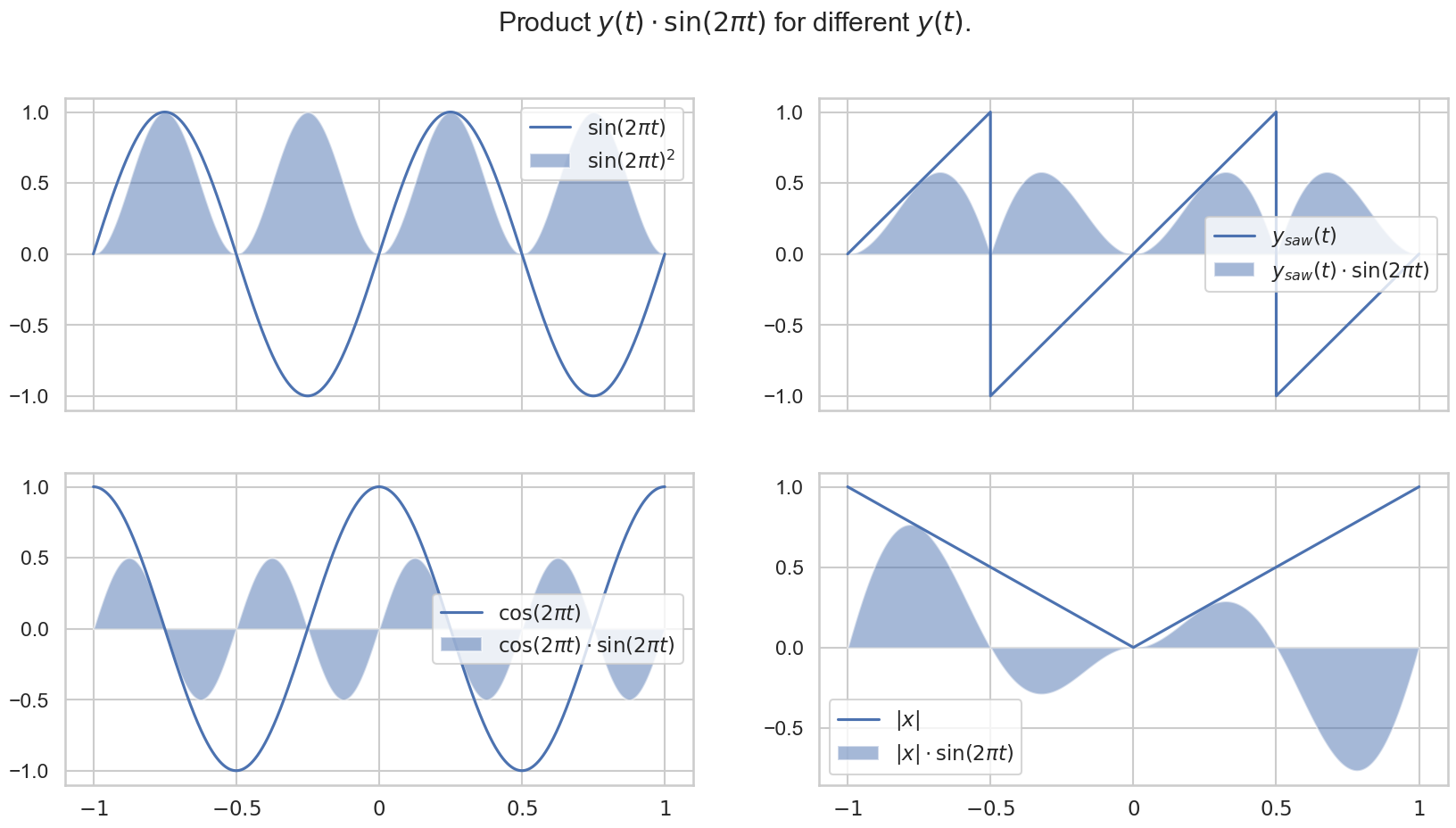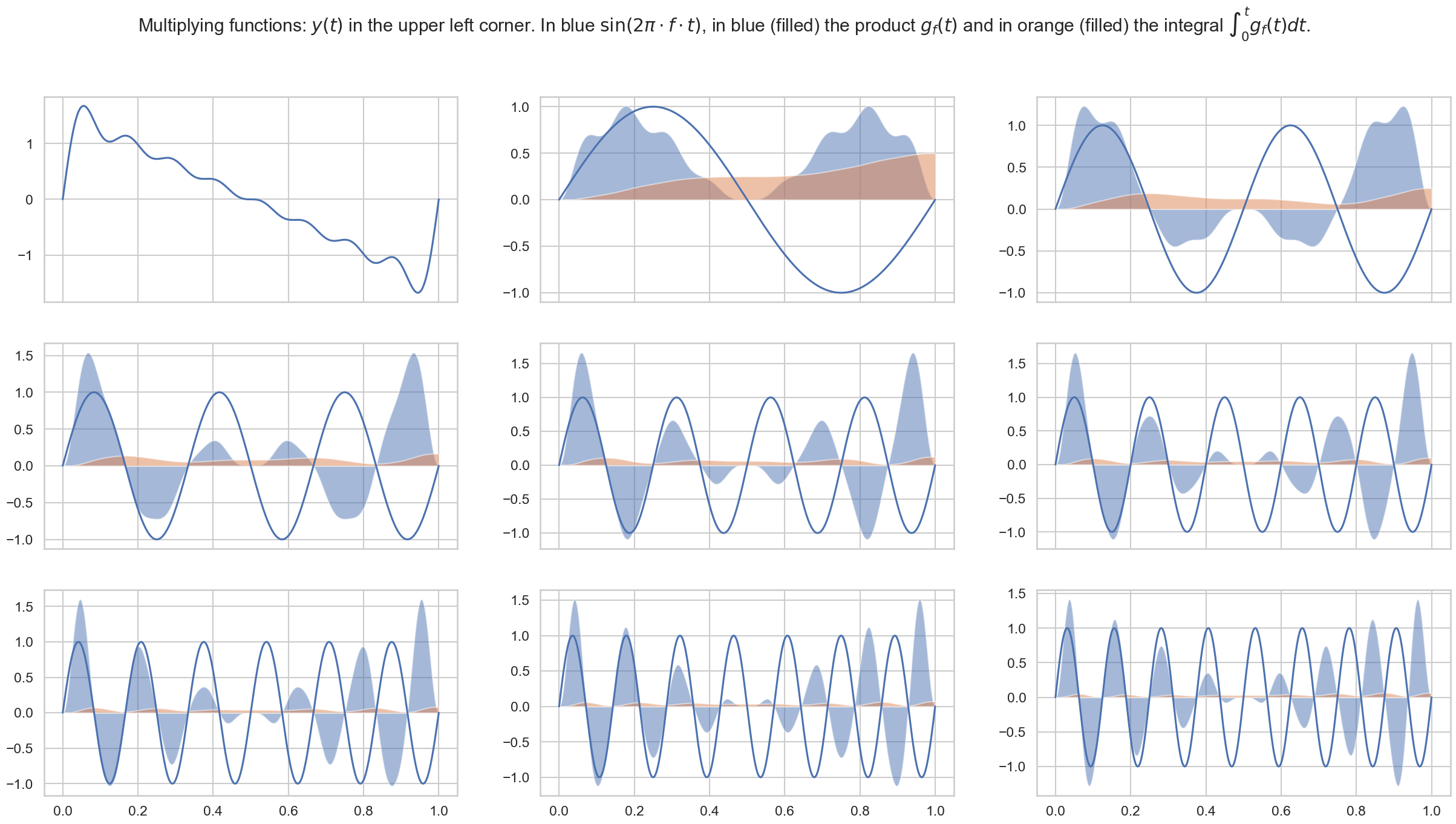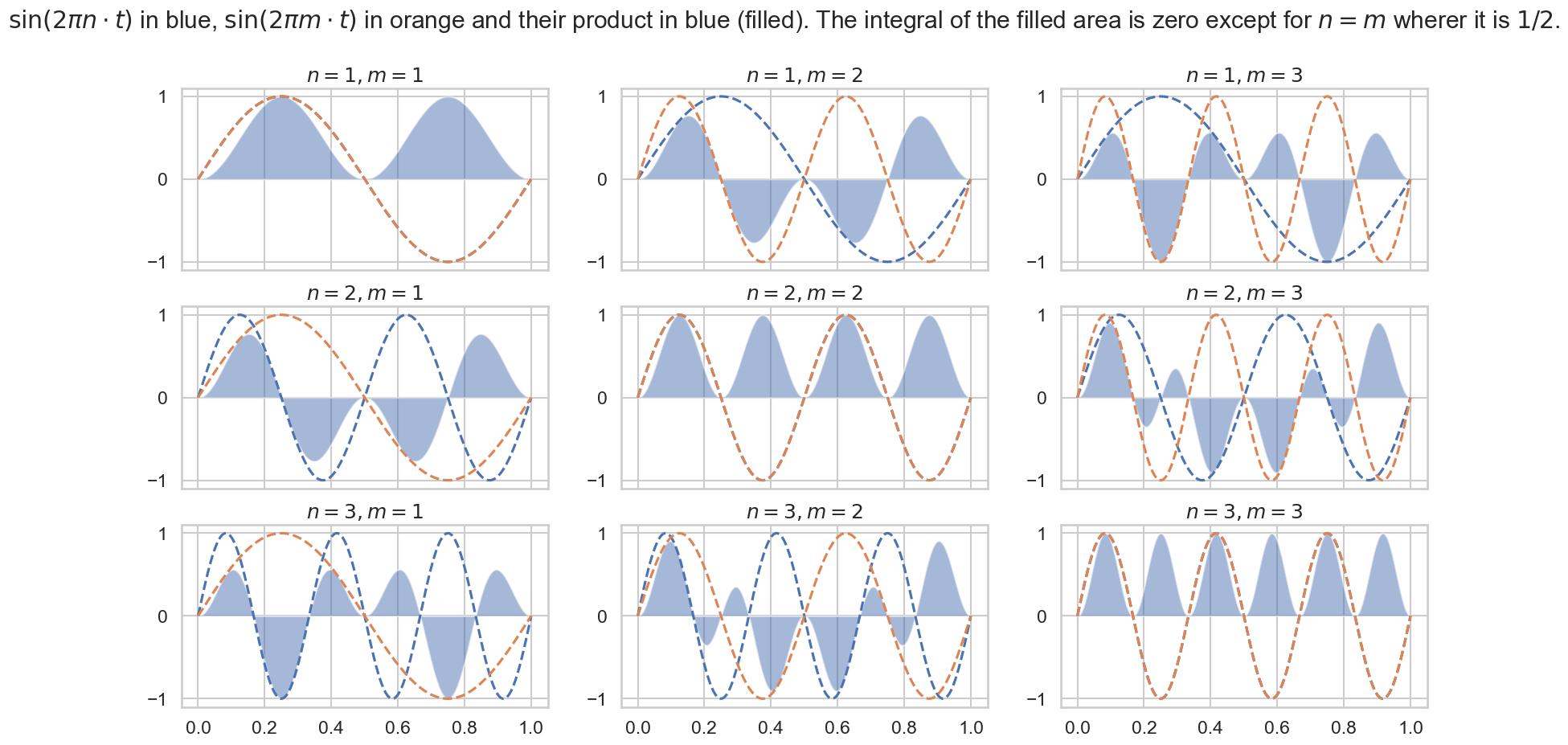Fourier Series#
L’étude profonde de la nature est la source la plus féconde de découvertes mathématiques. – Jean-Baptiste Joseph Fourier (1768–1830)
Given a signal \(y(t)\) of a played piano key, how can we compute the pitch, and how can we recreate that sound? Spectral analysis and synthesis give us some answers. By transforming the representation of a signal, we can catapult ourselves from the space of amplitude over time into the space of intensity over frequencies.
Example
Take the example of the simplest analog signal of all, a sine wave of period \(1\) second and amplitude 1:
A alternative representation would be
where \(\Omega\) is the angular frequency, meaning that if \(\Omega = 1\) we are asking for the intensity of of the frequency equal to one in \(y(t)\).
Also in section Additive Synthesis we use Fourier synthesis to construct complicated waveforms from a sum of simple sinusoids, i.e., a Fourier series. For example, the (periodic) sawtooth wave
can be constructed by an infinite sum
In mathematics, the meaning of transform and transformation is somewhat specific, but it still is relatively wide or loose. It is called a mathematical quantity obtained from a given quality by an algebraic, geometric, or functional operation. And in transform theory, mathematicians talk about a suitable choice of a function called kernel (from the German nucleus or core), by which a problem may be simplified.
In 1822 Jean-Baptise Joseph Fourier discovered a truly remarkable transformation which gives us insights into our knowledge of waveforms in general and music in particular. He claimed that any periodic function, whether continuous or discontinuous, can be transformed into a series of sines. That important work was corrected to
almost any periodic function can be represented by a Fourier series that converges.
and expanded upon by others to provide the foundation for various forms of the Fourier transform used since.
I find this result still fascinating. At this point, I have to mention that the great German mathematician Carl Friedrich Gauß already discovered this connection in 1805 and, what is even more remarkable, he formulated something quite similar to the fast Fourier transform (FFT)! His breakthrough was not widely adopted because it only appeared after his death in volume three of his collected works which was written with non-standard notation in a 19th-century version of Latin.
Especially since the re-discovery of the fast Fourier transform (FFT) in 1965 by Cooley and Tukey to detect underground tests of atomic bombs, the Fourier synthesis is a widespread technique performed in all areas of signal processing. There are so many applications of the FFT, from solving differential equations to radar and sonar, studying crystal structures, WiFi, and 5G. It is no surprise that the mathematician Gilbert Strang called the FFT
the most important numerical algorithm of our lifetime. – Gilbert Strang
But why is that? Well, it is all about computation speed! The FFT reduces the time complexity of the discrete Fourier transformation (DFT) from \(\mathcal{O}(n^2)\) to \(\mathcal{O}(n\log(n))\) which makes the computation of the DFT fast thus applicable for many areas and purposes.
Frequency Spectrum#
Before we dicuss the mathematical basis, let’s have a look at the frequency spectrum of a audio recordings such that we can picture what we want to compute. First let us use an audio recording of a physical piano. The note played is A0 = 440 Hz.
We can display the waveform of the signal
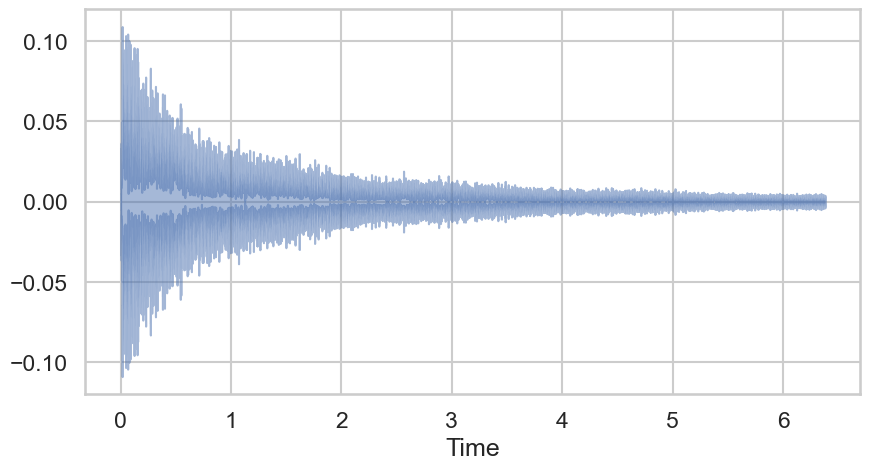
Fig. 18 Waveform, i.e., the audio signal in the time domain.#
as well as its frequency sprectrum.
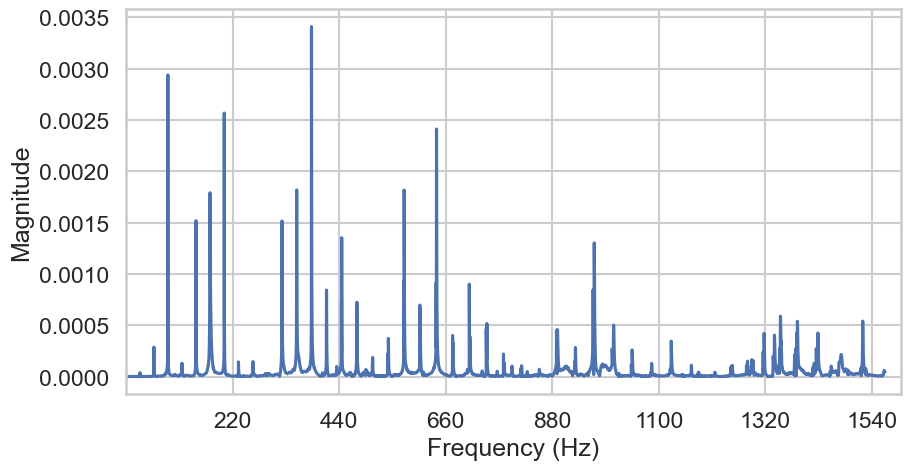
Fig. 19 Fourier coefficients, i.e., the audio signal in the frequency domain.#
The spectrum is computed by the discrete Fourier transform. As you can see, there are lower frequencies than the fundamental present and the signal consists of a lot inharmonic content. The piano might be out of tune.
Let us look at a second synthetic example:
The sound was generated by the following code.
({
var sig = SinOsc.ar(440 * [1,2,3,4,5]) * [0.5, 0.2, 0.2, 0.1, 0.1];
sig = Mix(sig);
[sig, sig];
}.play;)
We can display the wave form of the signal (here I only plot a very short time period)
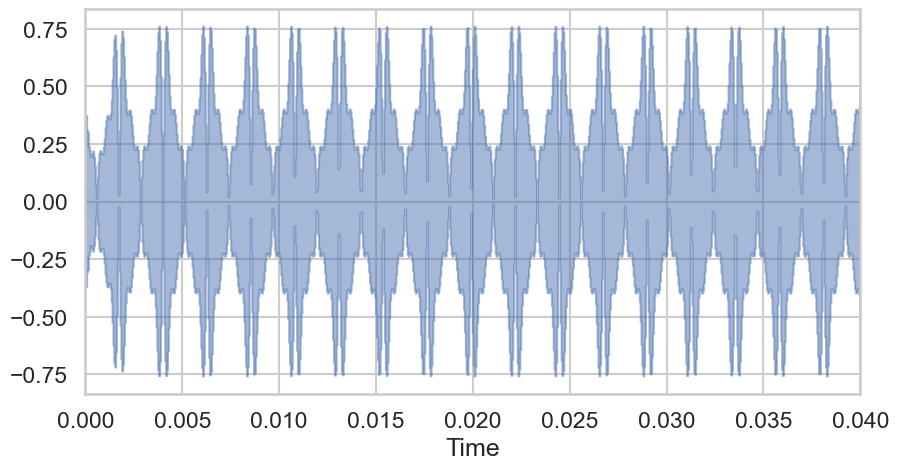
Fig. 20 Synthetic waveform, i.e., the audio signal in the time domain.#
as well as the frequency sprectrum
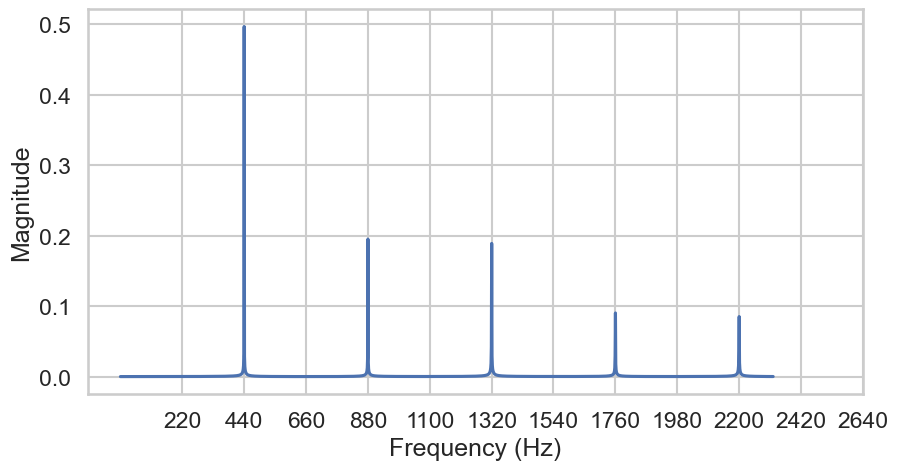
Fig. 21 Synthetic Fourier coefficients, i.e., the audio signal in the frequency domain.#
In the synthetic case, we get exaclty what we expected, i.e., 5 peaks, four harmonic overtones, and one fundamental at 440 Hz.
Similarity of Periodic Functions#
First we have to clarify that
Any periodic function \(y(t)\) has to have a fundamental frequency with period \(T\). It is the period after which it repeats, i.e. \(f(t) = f(t + Tn)\), with \(n \in \mathbb{N}\).
From this it follows that \(\int_0^{Tn} y(t) dt = n\int_0^{T}dt\) with \(n \in \mathbb{N}\).
Let us start from the assumption that the Fourier theorem is correct (which it is). So we assume, that we can built any periodic vibration/signal using a combination of sinusiods whose frequencies are integer multiple of a fundamental frequcency. Our job is to find the correct amplitudes and phases of these sinusiods. Let’s ignore the phase for a moment. For now we assume that all phases are zero.
The question that we have to answer is: how much of a specific sinusoidal is in \(y(t)\). If the answer is a lot, then the amplitude of the respective sinosoid should be large. Therefore, computing sinusoidals that are similar to \(y(t)\) seems to be a good starting point. Instead of similarity one speaks of cross-correlation which is a measure of similarity of two series as a function of the displacement of one relative to the other, also known as sliding dot product or sliding inner-product.
Functions are similar if their product result in a positive function. In other words, if the integral of their product is positive.
In the following plot we can see this intuition at play. The integral of \(\sin(2\pi t)^2\) gives us \(0.5\), i.e., there is alot of \(\sin(2\pi t)\) in \(\sin(2\pi t)\). We also get a positive value for the integral of \(\sin(2\pi t)\) multiplied with the sawtooth wave. The integrals of the other products are zero.
( // generate the y(t) * sin(2*pi*u)
{[
SinOsc.ar(1) * SinOsc.ar(1),
LFSaw.ar(1) * SinOsc.ar(1),
SinOsc.ar(1) * SinOsc.ar(1,0.5*pi),
LFTri.ar(0.5)*(-1)*SinOsc.ar(1)
]}.plot(1)
)
Let’s have a look at the sum of the first terms of the sawtooth wave:
For shorthand let us also define the product with a sine wave of a certain frequency of \(n \in \mathbb{N}\) Hz:
({
var sines = Array.fill(8, {arg i; 1/(i+1) * SinOsc.ar(i+1);});
var y = Mix(sines);
[y]++Array.fill(8, {arg i; y*SinOsc.ar(i+1)});
}.plot(1)
)
We get
In general we get
Why is that? Well because \(\forall n \in \mathbb{N}:\)
thus
holds and
holds. Finally, using ``(29) and the rule of integration for addition, we can follow that
holds because all terms integrate to zero except where \(n=m\).
Perpendicular Functions
For all frequencies \(n, m \in \mathbb{N}\) with \(n \neq m\)
holds. We say that \(\sin(2\pi n \cdot t)\) is perpendicular to \(\sin(2\pi m \cdot t)\).
({ // generate sin(2*pi*i*x) * sin(2*pi*j*x)
var sines = Array.fill(3, {arg i; 1/(i+1) * SinOsc.ar(i+1);});
var y = Mix(sines);
var indices = Array.fill2D(3, 3, {arg row, col; [row,col];}).flatten;
indices.collect({arg index; var i = index[0], j = index[1];
SinOsc.ar(i+1)*SinOsc.ar(j+1)
});
}.plot(1)
)
We say that these functions are perpendicular to each other because their scalar product (the integral of their product) is zero!
Following up on this, the similarity measure of two functions is similar to the similarity of two vectors. One way to compare two vectors \(\mathbf{a} = (a_1, \ldots, a_n)\) and \(\mathbf{b} = (b_1, \ldots, b_n)\) is to compute their inner product. If two vectors \(\mathbf{a}, \mathbf{b}\) are perpendicular, i.e., if they are very different, their inner product
is zero. Their inner product is large if they are similar. We can define the inner product of two functions \(h: \mathbb{R} \rightarrow \mathbb{R}\) and \(g: \mathbb{R} \rightarrow \mathbb{R}\) in a similar fashion. The sum changes to an integral.
Inner Product of two Functions
Let \(h: \mathbb{R} \rightarrow \mathbb{R}\) and \(g: \mathbb{R} \rightarrow \mathbb{R}\) then
is the inner product of \(h\) and \(g\). It is a measure of the similarity of \(h\) and \(g\).
We can conclude that our steps works if \(y(t)\) is not a sawtooth wave but also if some frequencies are missing. However, if some sine waves are shifted or if their frequencies are non-integral, it is not yet clear our steps still work.
Fourier Synthesis#
But let us start from the beginning, i.e., from the Fourier series. The process of constructing a periodic function by a Foruier series is called Fourier synthesis.
Fourier Series (FS)
A Fourier series is a sum that represents a periodic function as a sum of sine and cosine waves. The frequency of each wave in the sum is an integer multiple of the periodic function’s fundamental frequency. The Foruier series in amplitude-phase form \(y_N(t)\) of a periodic function \(y(t)\) is defined by
where \(N\) is potentially equal to infinity. \(T = \frac{1}{f_0}\) is the period of \(y(t)\), \(A_n\) is the \(n\)-th hermonic’s amplitude and \(\phi_n\) is its phase (shift). \(A_0/2\) is the direct current (DC) component/bias, with
which is the mean of \(y(t)\). \(f_0\) is the fundamental frequency of the signal.
Except for pathological functions, any periodic function can be represented by a Fourier series (FS) that converges. Convergence of Fourier series means that as more and more harmonics from the series are summed, each successive partial Fourier series sum will better approximate the function, and will equal the function with a potentially infinite number of harmonics.
Still, we did not proof for completeness, that is, that we really can represent all periodic function in this way. For that one has to prove that our orthogonal functions are in fact a complete basis for \(L^2([0,T])\), meaning that if a function \(h\) is orthogonal to all our basis, it follows that \(f = 0\) (in \(L^2\))! We will not prove this because it is not important for our application but it is true. If you want to have a look you can find a proof here. I hope I could you provide a good intuition.
Fourier Theorem
Except for pathological functions, any periodic vibration/signal, no matter how complicated it seems, can be built up from sinusoids whose frequencies are integer multiples of a fundamental frequency, by choosing the proper amplitudes and phases.
Note that non-periodic functions can be handled using an extension of the Fourier series called the Fourier transform which treats non-periodic functions as periodic with infinite period. This transform thus can generate frequency domain representations of non-periodic functions as well as periodic functions, allowing a waveform to be converted between its time domain representation and its frequency domain representation.
Next we want to but things together and compute all frequency intensities and phases assuming the Fourier theorem is correct, i.e. we assume we can synthesize any periodic function using the definition above.
Fourier Analysis#
Until now, we assumed that all phase shifts are zero and that the period of the fundamental \(T\) is \(1\). Then we concluded that if we compute the integral of signal \(y(t)\)—a sawtooth wave—multiplied with a sinusoid of the same phase we get:
either some \(2A_n/T\) positive number (similarity) where \(A_n\) was the frequncy intensity of frequency \(n \in \mathbb{N}\)
or zero, in this case \(y(t)\) is perpendicular to the sinusoid (non-similarity)
We can easily adapt to an arbitrary period \(T\) if we change the intergrals accordingly. Then, to find the correct phase \(\phi_n\), we can reformulate the problem of similarity into an optimization problem. Let’s say \(y(t)\) is our an analog signal (its no longer a sawtooth wave but some arbitrary signal). And let us reconsider the Fourier series:
We can multiply a single term of the sum of \(y_N(t)\) with our signal \(y(t)\) and integrate over the period of our signal to compute the measure of similarity:
Following our discussion at the start of section Similarity of Periodic Functions, at the maximum of \(Y_n(\phi)\) the integral is equal to the amplitude \(A_n \cdot T/2\). If the respective sinusoid is part of the Fourier series
is non-zero, otherwise it is. Therefore, we multiply the integral by \(2/T\) to get \(A_n\). Furthermore, we get the missing phase shift defined by
Using the equivalence of polar and Cartesian forms, that is,
We can simplify \(Y_n(\phi)\):
The derivative of \(Y_n(\phi)\) is zero at the phase of maximum correlation. Threfore,
holds and the correlation peak value is:
In other words, \(a_n\) and \(b_n\) are the Cartesian coordinates of a vector with polar coordinates \(A_n\) and \(\phi_n\). That is quite remarkable. Furthermore, we can write the Fourier series replacing Eq. (28) using \(a_n\) and \(b_n\) instead of \(A_n\):
where \(a_0 = A_0\). In this formula, the phase \(\phi\) is encoded in the interplay between sine and cosine.
Recalling complex numbers, remember that
and
holds. Therefore, we can write the Fourier series of a function in complex form by adapting Eq. (29):
Here we have used the following notations:
We finally arrive at the Fourier series in its exponential form.
Fourier Series (FS) in its Exponential Form
The Foruier series in exponential form \(y_N: \mathbb{R} \rightarrow \mathbb{C}\) of a periodic function \(y: \mathbb{R} \rightarrow \mathbb{C}\) is defined by
where \(N\) is potentially an infinite integer. \(T\) is the period of \(y(t)\), \(A_n\) is the \(n\)-th hermonic’s amplitude \(c_n\) is defined by
This form generalizes to complex-valued functions.
In this form phase and amplitude are represented by a phasor, e.g., \(A_n / 2 e^{-i \phi_n}\) and we can re-define \(Y_N : \mathbb{Z} \rightarrow \mathbb{C}\)
to be the phasor of the respective sinusoid with frequency \(n\) times the fundamental frequency \(f_0\) of the Fourier series of a (real) periodic function \(y(t)\) with period equal to \(1/f_0\).

